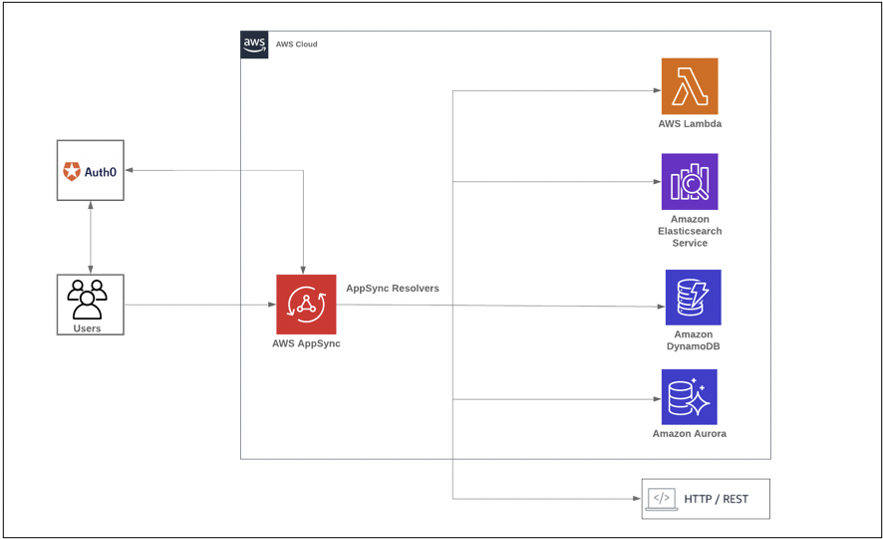Front-End Web & Mobile
Tag: AppSync
Building Real-time Serverless APIs with PostgreSQL, CDK, TypeScript, and AWS AppSync
September 14, 2021: Amazon Elasticsearch Service has been renamed to Amazon OpenSearch Service. See details. AWS AppSync is a managed serverless GraphQL API service that simplifies application development by letting you create a flexible interface to securely access, manipulate, and combine data from one or more data sources with a single network call and API […]
Practical use cases for AWS AppSync Pipeline Resolvers – Part 1: Quota Management
This article was written by Salman Moghal, Application Architect, AWS, and Abdul Kitana, Security Architect, AWS Overview AWS AppSync is a fully managed service that allows to deploy Serverless GraphQL backends in the AWS cloud. It provides features that developers can use to create modern data driven applications allowing to easily query multiple databases, microservices, […]
Practical use cases for AWS AppSync Pipeline Resolvers – Part 2: Data Aggregation
This article was written by Salman Moghal, Application Architect, AWS, and Abdul Kitana, Security Architect, AWS Overview AWS AppSync is a fully managed service that allows to deploy Serverless GraphQL backends in the AWS cloud. It provides features that developers can use to create modern data driven applications allowing to easily query multiple databases, […]
Practical use cases for AWS AppSync Pipeline Resolvers – Part 3: Heterogeneous Data Sources
This article was written by Salman Moghal, Application Architect, AWS, and Abdul Kitana, Security Architect, AWS Overview AWS AppSync is a fully managed service that allows to deploy Serverless GraphQL backends in the AWS cloud. It provides features that developers can use to create modern data driven applications allowing to easily query multiple databases, […]
Use existing Cognito resources for your Amplify API, Storage and more
This post was written by Rene Brandel, Senior Product Manager, AWS In this guide you will learn how to integrate your existing Cognito User Pool & Federated Identities (Identity Pool) into an Amplify project. This will enable your GraphQL API (AppSync), Storage (S3) and other resources to leverage your existing authentication mechanism. AWS Amplify is […]
AppSync adds support for AWS WAF
This article was written by Brice Pellé, Principal Specialist Solutions Architect, AWS AWS AppSync is a fully managed service that allows you to deploy Serverless GraphQL backends in the AWS cloud. With AppSync, you can have GraphQL backends that connect to multiple data sources, and that scale and grow with your usage. Whether you […]
Building Scalable GraphQL APIs on AWS with CDK, TypeScript, AWS AppSync, Amazon DynamoDB, and AWS Lambda
October 16, 2023: This post has been updated to include the latest CDK AppSync Constructs. September 14, 2021: Amazon Elasticsearch Service has been renamed to Amazon OpenSearch Service. See details. AWS AppSync is a managed serverless GraphQL service that simplifies application development by letting you create a flexible API to securely access, manipulate, and combine […]
Building cross-account AWS Lambda Resolvers for AWS AppSync
This article was written by Lucas Schejtman, Principal Solutions Architect, AWS One of the biggest value propositions of GraphQL is that it’s not prescriptive as to where its data comes from and with AWS AppSync it’s no different. AppSync enables you to choose from six different data source types to resolve any GraphQL field. […]
Using Okta as an Identity Provider for GraphQL APIs with AWS AppSync
This article was written by Jana Gnanachandran and Raghavarao Sodabathina, Enterprise Solutions Architects, AWS September 14, 2021: Amazon Elasticsearch Service has been renamed to Amazon OpenSearch Service. See details. AWS AppSync is a managed serverless GraphQL service that simplifies application development by letting you create a flexible API to securely access, manipulate, and combine data […]
Using Auth0 as an Identity Provider for GraphQL APIs with AWS AppSync
This article was written by Raghavarao Sodabathina and Jana Gnanachandran, Enterprise Solutions Architects, AWS September 14, 2021: Amazon Elasticsearch Service has been renamed to Amazon OpenSearch Service. See details. AWS AppSync is a managed serverless GraphQL service that simplifies application development by letting you create a flexible API to securely access, manipulate, and combine data […]







